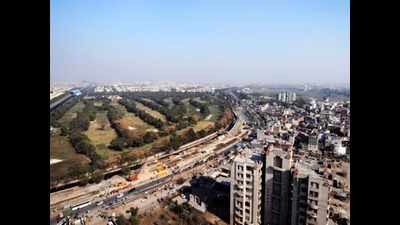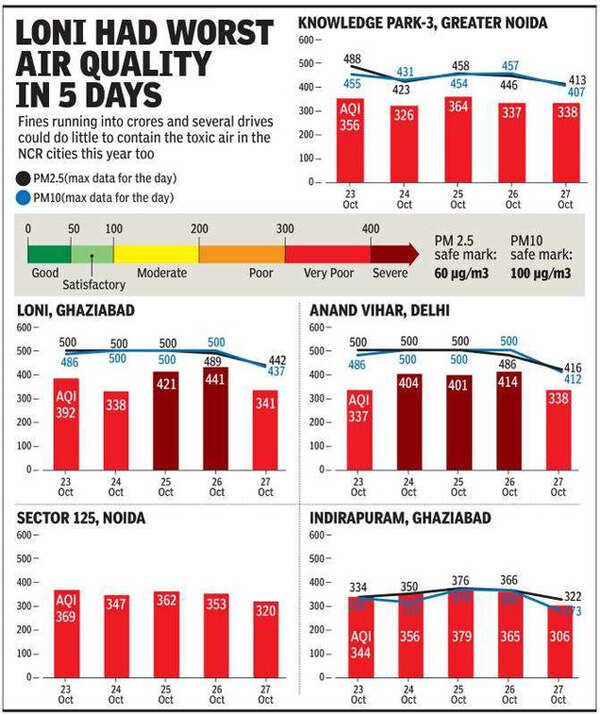- News
- City News
- noida News
- Greater Noida, Loni emerge pollution hotspots
Trending
This story is from October 28, 2020
Greater Noida, Loni emerge pollution hotspots
Greater Noida — one of the greenest urban areas near Delhi — and Loni have emerged as pollution hotspots in NCR. The AQI levels in these two areas have been hovering between the ‘very poor’ and ‘severe’ categories since October 22. Greater Noida has also seen more ‘very poor’ days than Delhi in October.

Aerial view of Noida
NOIDA/GHAZIABAD: Greater Noida — one of the greenest urban areas near Delhi — and Loni have emerged as pollution hotspots in NCR. The AQI levels in these two areas have been hovering between the ‘very poor’ and ‘severe’ categories since October 22. Greater Noida has also seen more ‘very poor’ days than Delhi in October.
Track the pollution level in your city
Fines running into crores and several drives could do little to contain the toxic air in the city.And this year, the air quality deteriorated to the ‘very poor’ level for the first time in mid-October in most NCR cities.

In Ghaziabad’s Loni, recycling of e-waste and dust remain the major causes of air pollution.
Kuldeep Srivastava, head of India Meteorological Department (IMD)’s regional weather forecasting centre, attributed the high pollution level in Greater Noida to dust, construction waste, industries and the topography of the region. “Since Greater Noida is situated on the city’s fringes, toxic air due to stubble burning and the wind direction directly contributes to the high pollution level in the area. However, if local factors such as dust and construction waste are kept under check, pollution levels will come down significantly,” he added.
City-based environmentalist Vikrant Tongad, however, blamed the Greater Noida administration for the rising pollution levels. “In September, an inspection was carried out in Greater Noida and it was found that there are at least 11 stretches that are unpaved. Also, construction activities have given rise to dust,” Tongad said, adding that if that was not enough, industrial pollution from Chaupraula and Ghaziabad has only worsened the problem in Greater Noida. “And the authority has taken very little measures so far to contain it,” he said.
Chief executive officer of Greater Noida Industrial Development Authority Narendra Bhooshan said that they are taking help from experts to carry out qualitative research to contain the situation. “Drives are also being carried out to identify polluters and hefty fines are being imposed,” he said, adding that residents can also report violations by dialing 0120 - 2336046/47/48 or can WhatsApp on 8800203912.
To grapple with the situation, the Ghaziabad administration, taking cognizance of TOI report on how Delhi’s e-waste is turning the air toxic in Loni, has written to Delhi government officials to prepare a composite plan to tackle the e-waste problem. District magistrate Ajay Shankar Pandey said, “We have written to the East Delhi Municipal Corporation about the need to work on a composite plan to deal with pollution in the area, especially with regard to e-waste that gets ferried into Loni from the capital.”
Pandey added, “We have stressed on the need to maintain round-the-clock vigil at the border so that e-waste does not get ferried into Loni. In addition, we have urged the state government to set up an e-waste recycling plant at the earliest.”
In Loni, apart from dust and construction waste, illegal factories engaged in retrieving e-waste and metals contribute the most to rising pollution levels.
Sishil Raghav, a Ghaziabad-based environmentalist, said that due to its proximity to Delhi, e-waste in tonnes are ferried from across Delhi and during night these are dipped in drums of chemicals heated in pit-furnace to retrieve saleable metals. “The toxic fumes generated in the process gets mixed with air resulting in a sudden spike in PM10 and PM2.5 pollutants in the vicinity and it all happens in connivance with the officials,” Raghav added.
Loni sub-divisional magistrate Khalid Anjum agreed that there are a few illegal factories which are engaged in recycling waste through crude and unscientific ways.
“As per estimates, there are more than 1,000 illegal units that are operating in areas such as Amit Vihar, Krishna Vihar, Ankit Vihar and Sewa Dham. These units mostly use coal and other cheap fuels to heat the furnace which leads to spike in air pollution levels.”
Track the pollution level in your city
Fines running into crores and several drives could do little to contain the toxic air in the city.And this year, the air quality deteriorated to the ‘very poor’ level for the first time in mid-October in most NCR cities.

This year too, Uttar Pradesh Pollution Control Board (UPPCB) has identified 11 dust bowl stretches in Greater Noida, and apart from construction activities, these factors make Greater Noida and Noida a pollution hotbed in NCR.
In Ghaziabad’s Loni, recycling of e-waste and dust remain the major causes of air pollution.
Kuldeep Srivastava, head of India Meteorological Department (IMD)’s regional weather forecasting centre, attributed the high pollution level in Greater Noida to dust, construction waste, industries and the topography of the region. “Since Greater Noida is situated on the city’s fringes, toxic air due to stubble burning and the wind direction directly contributes to the high pollution level in the area. However, if local factors such as dust and construction waste are kept under check, pollution levels will come down significantly,” he added.
City-based environmentalist Vikrant Tongad, however, blamed the Greater Noida administration for the rising pollution levels. “In September, an inspection was carried out in Greater Noida and it was found that there are at least 11 stretches that are unpaved. Also, construction activities have given rise to dust,” Tongad said, adding that if that was not enough, industrial pollution from Chaupraula and Ghaziabad has only worsened the problem in Greater Noida. “And the authority has taken very little measures so far to contain it,” he said.
Chief executive officer of Greater Noida Industrial Development Authority Narendra Bhooshan said that they are taking help from experts to carry out qualitative research to contain the situation. “Drives are also being carried out to identify polluters and hefty fines are being imposed,” he said, adding that residents can also report violations by dialing 0120 - 2336046/47/48 or can WhatsApp on 8800203912.
To grapple with the situation, the Ghaziabad administration, taking cognizance of TOI report on how Delhi’s e-waste is turning the air toxic in Loni, has written to Delhi government officials to prepare a composite plan to tackle the e-waste problem. District magistrate Ajay Shankar Pandey said, “We have written to the East Delhi Municipal Corporation about the need to work on a composite plan to deal with pollution in the area, especially with regard to e-waste that gets ferried into Loni from the capital.”
Pandey added, “We have stressed on the need to maintain round-the-clock vigil at the border so that e-waste does not get ferried into Loni. In addition, we have urged the state government to set up an e-waste recycling plant at the earliest.”
In Loni, apart from dust and construction waste, illegal factories engaged in retrieving e-waste and metals contribute the most to rising pollution levels.
Sishil Raghav, a Ghaziabad-based environmentalist, said that due to its proximity to Delhi, e-waste in tonnes are ferried from across Delhi and during night these are dipped in drums of chemicals heated in pit-furnace to retrieve saleable metals. “The toxic fumes generated in the process gets mixed with air resulting in a sudden spike in PM10 and PM2.5 pollutants in the vicinity and it all happens in connivance with the officials,” Raghav added.
Loni sub-divisional magistrate Khalid Anjum agreed that there are a few illegal factories which are engaged in recycling waste through crude and unscientific ways.
“As per estimates, there are more than 1,000 illegal units that are operating in areas such as Amit Vihar, Krishna Vihar, Ankit Vihar and Sewa Dham. These units mostly use coal and other cheap fuels to heat the furnace which leads to spike in air pollution levels.”
End of Article
FOLLOW US ON SOCIAL MEDIA










